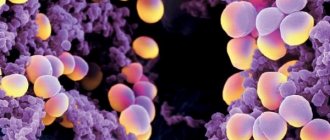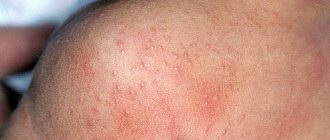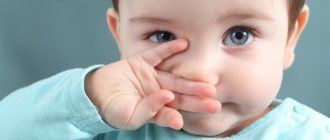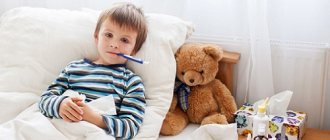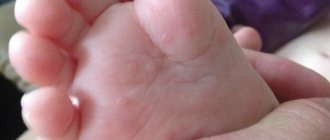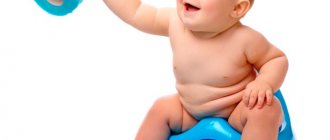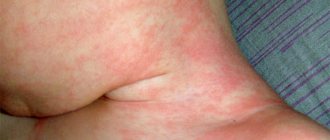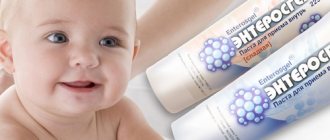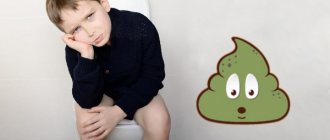There is probably no child in the world who has never had a runny nose in their life. This disease is always “current”: in the summer it can be drafty, a reaction to pollen or fluff is possible, and it is easy to catch a cold in the fall and winter. It is entirely justified for parents to ask why a small child has a runny nose and how it can be treated. All children sooner or later encounter this disease. And although it is considered quite light, it significantly affects the condition of the baby. There are methods designed to make you feel better and speed up recovery.
Causes of runny nose in children
The most common cause of a runny nose in a child is a viral infection. Pathogenic microbes injure the mucous membrane of the nasopharynx and penetrate into it, spreading further throughout the body. The process of virus reproduction occurs very quickly: in just a few hours they affect the entire upper respiratory tract.
Why does a child develop a runny nose without other symptoms during ARVI? The answer is simple - an imperfect immune system does not immediately recognize the invasion of foreign particles, and therefore does not respond in time. Fever and other signs of a cold appear a little later.
ARVI is not the only cause of a runny nose without other symptoms. Rhinitis can develop in a child for other reasons. Here are some of them:
- allergic reaction in response to irritating substances;
- prolonged exposure to cold air;
- inhalation of tobacco smoke.
An experienced doctor should determine the cause of a runny nose without fever and other symptoms in children. To maintain and strengthen your child’s health, do not self-medicate and immediately seek advice from a specialist.
Medicines for the treatment of childhood rhinitis
Medicines prescribed to a child must be harmless and consist of natural ingredients.
Medicines for the common cold for children are:
- vasoconstrictors,
- for washing,
- antihistamines,
- moisturizing,
- homeopathic,
- anti-inflammatory.
Children's vasoconstrictor drugs contain an active substance represented by oxymetazoline or xylometazoline.
Vasoconstrictor drugs include:
- children's Tizin,
- Snoop,
- Nazol Kids,
- Nazivin.
Anti-inflammatory drugs include protargol. Doctors prescribe it to children over five years old. But if the situation forces it, then a drug containing silver ions is prescribed to a three-year-old child.
You should be careful with Pinosol. It consists of essential oils of mint, eucalyptus, pine and can cause allergies if you are individually intolerant to these components.
Salil, based on sodium chloride, has an anti-inflammatory effect.
Children are given nasal rinsing to prevent the virus from multiplying. Aqua Maris or Otrivin are used. The preparations are harmless to the child’s body and consist of purified water and sea salt.
Antihistamines are prescribed if a runny nose is caused by an allergic reaction to an external irritant. For example, Vibrocil.
Methods to combat rhinitis
Beating a runny nose is easy if you know what to do. Drug therapy for a viral infection is prescribed by a doctor. Experts often include Derinat nasal drops in the ARVI treatment regimen. Thanks to the dosage form, the drug easily penetrates the site of inflammation and has a complex effect:
- promotes the destruction of infectious agents - viral particles;
- helps strengthen natural immune defenses;
- has a reparative (healing) effect on the nasal mucosa, restoring its barrier functions.
To speed up recovery and alleviate the child’s condition, you can supplement drug therapy with traditional methods of fighting infection. For a runny nose without fever or other symptoms, the following are useful:
- warm foot baths with the addition of a few drops of tangerine, juniper or orange essential oils;
- steam inhalation over boiled potatoes;
- plenty of warm drink - tea with lemon and honey, decoction of rose hips or raspberry leaves, milk with butter, compote of dried apricots and prunes, cranberry or lingonberry juice;
- rinsing the nasal passages with saline solution diluted with aloe juice.
If a child often gets a runny nose, after recovery it is important to take care of preventing re-infection during the flu and cold season. To solve this problem, doctors often prescribe Derinat. How to use nasal drops for preventive purposes, check with a specialist and read the instructions for use. Take care of your children and don't get sick yourself!
Source
Traditional methods
As an auxiliary treatment, you can resort to the use of traditional medicine.
Eucalyptus
Eucalyptus-based inhalations have a good therapeutic effect. This procedure will soften the mucous discharge, speed up the process of its discharge, and eliminate inflammatory changes caused by the flow of mucus along the walls of the larynx. Treatment with this method can only be done if the child does not have an elevated body temperature.
There are also other methods that can effectively treat internal rhinitis.
Aloe
Aloe will help get rid of the problem. To prepare the medicine, you need to remove the skin from the fresh leaf of the plant, then chop it and mix it with natural honey. Use the prepared mixture twice a day. Treatment is carried out until the mucous discharge from the larynx is completely eliminated; Quite effective and, importantly, a completely safe healing substance is propolis.
The beekeeping product is ground to a powder, then poured with a glass of boiled water. The drug is allowed to brew until the wax and other impurities float to the surface and the propolis settles to the bottom. The resulting precipitate is poured with alcohol - 100 g of alcohol per 30 g of propolis. The mixture is infused for a week, after which the throat is lubricated with it.
Calendula
How can you treat an unpleasant illness using calendula petals in combination with natural honey. The petals of the medicinal plant should be thoroughly washed and mixed with bee honey in a 1:1 ratio. Take a spoon after each meal. Continue treatment until the internal runny nose is completely eliminated.
Diet plays a special role in the treatment of the disease. Experts recommend excluding foods high in fat, spicy and fried foods from the child’s diet during treatment. It is also advisable, if possible, not to feed before bedtime.
With timely diagnosis and proper treatment, the unpleasant symptom will not linger for long, and the risk of developing serious complications will be reduced to zero.
Doctor Komarovsky about the treatment of a runny nose in a child
A runny nose is a frequent guest in families where children grow up. Everyone knows that nasal congestion is not an independent disease, it is only a symptom. Moreover, he can talk about a wide variety of diseases. However, in most families, mothers and fathers continue to treat their child for a runny nose. This therapy is sometimes long-term. The famous children's doctor Evgeny Komarovsky tells what a runny nose “signals” to adults, and what parents should do so that their child can breathe easily and simply.
About the problem
Even the most caring mother, who takes care of and protects her child from everything in the world, will not be able to ensure that her child never gets a runny nose in his life. This is because rhinitis (the medical name for the runny nose) most often occurs during acute viral respiratory infections. At the physiological level, the following happens: one of the many viruses that always surround the child gets onto the nasal mucosa. In response, the immune system gives the command to secrete as much mucus as possible, which should isolate the virus from other organs and systems, preventing it from moving further through the nasopharynx, larynx, bronchi and lungs.
Treatment of viral runny nose
Viral rhinitis is the most common among children and does not require treatment as such. The mucus produced by the membranes of the nose contains special substances that are very important for fighting the virus that has entered the body. However, the beneficial properties of mucus will end immediately after the snot becomes thick. As long as they flow, everything is fine, parents can calm down.
But if suddenly the nasal mucus thickens, becomes green, yellow, yellow-green, purulent, purulent with impurities of blood, it ceases to be a “fighter” against the virus and becomes an excellent breeding ground for bacteria. This is how a bacterial runny nose begins, which will require treatment with antibiotics.
Thus, with a viral runny nose, the main task of parents is to prevent the mucus in the nose from drying out. The snot should remain liquid. That’s why Evgeniy Komarovsky recommends not looking for pharmacy magic nose drops, because there are no cures for viruses, but simply rinsing the child’s nasal cavity with saline solutions, and doing this as often as possible (at least every half hour). To prepare the solution, you need to take a teaspoon of salt per liter container of boiled chilled water. The resulting solution can be dripped, washed out of the nose using a disposable syringe without a needle, or sprayed with a special bottle.
For instillation, you can use other means that help thin the nasal mucus - “Pinosol”, “Ectericide”. Washing with the most common saline solution, which can be bought inexpensively at any pharmacy, effectively thins snot.
The drying out of nasal mucus, which is so necessary during the body’s fight against viruses, is facilitated by stuffy and dry air in the room and the lack of a sufficient amount of fluid in the body. Therefore, the room where a child with a runny nose is located should be ventilated and wet cleaned. The air must be humidified to 50-70% . Special devices - humidifiers - will help parents with this. If there is no such miracle of technology in the family, you can place basins of water in the corners of the room so that it can evaporate freely, hang wet towels on the radiators and make sure that they do not dry out. A child who often suffers from rhinitis should definitely be given an aquarium with fish.
Folk remedies for children's runny nose
Treatment of a runny nose with folk remedies
Typically, pediatricians do not recommend experimenting with folk remedies when treating a small child. They can cause allergies, burn the mucous membrane, and increase swelling.
From the age of three, some of them are already considered safer:
- Mustard plasters. Our grandmothers' remedy. Each of us installed mustard plasters in childhood. You can simply pour mustard into the child’s socks, and before that, steam your feet if there is no fever. Rubbing your feet with badger fat or special baby cream Barsukor helps a lot with a runny nose.
- If there is no swelling, but snot is flowing, you can warm your nose. Only if there are no hints of sinusitis. To do this, you can boil an egg, potato or salt in a rag bag and apply it to the bridge of your nose. Keep it like this until it cools down.
- You can rub the child's chest and back with diluted essential oils of eucalyptus, mint, and pine. Never apply pure oil. To make a rubbing, add a few drops of essential oil to the base oil (baby oil, vegetable oil). This will make your baby's breathing easier.
- Some mothers treat a runny nose with a mixture of honey and aloe juice. This method can be effective, but in other cases it can cause an allergic reaction, since honey is a strong allergen. If you want to use this method, apply the mixture to the crook of your child's elbow first and see if there is any rash or redness.
- Children's runny noses are also treated with beet juice and they even put tampons in the nose from beet pulp for a long time. Using this method on a child can be dangerous; beets cause pain, irritation of the mucous membranes, and burns are possible. At best, you can dilute fresh beet juice with water and drop a couple of drops into the child’s nose.
- Onion juice is known for its disinfecting properties. However, if you want to put it in the nose of a small child, try this method on yourself first. Pure onion juice will cause such pain, burning and irritation of the mucous membrane that you will want to climb the wall. The child can inhale over onion vapor or dilute the juice very much with water before use.
Treatment of bacterial rhinitis
If the snot changes color, consistency, becomes thick, green, or purulent, you should definitely call a doctor. Bacterial infection is a serious matter, and airing alone cannot do it. In most cases, your child will need antibiotic nasal drops. But before prescribing, the doctor will definitely examine the extent of the inflammatory process and only then will decide in what form to give the child antibiotics - in tablets (for an extensive infection with additional symptoms) or in drops.
Komarovsky’s recommendations regarding air humidity, air temperature, wet cleaning, ventilation and plenty of warm drinking for a runny nose caused by microbes also remain in force.
Prevention
Any disease is easier to prevent than to cure. A strong baby with good immunity gets sick much less often. Help to make it like this:
- Hardening procedures.
- General strengthening gymnastics.
- Complete and rational nutrition.
- Long walks in the fresh air.
- Fortification (regular intake of complexes of vitamins and minerals).
- Optimal indoor climate (normal humidity level, temperature - +18C - +20C).
- Cleanliness in the apartment, regular wet cleaning.
- Elimination of the allergen after undergoing a special examination.
- The use of antiviral drugs as prescribed by a doctor during the epidemic of acute respiratory infections and acute respiratory viral infections.
Treatment of a runny nose should be a mandatory measure and have an integrated approach: only a combination of therapeutic measures will bring the desired effect - to get rid of a runny nose completely.
Treatment of allergic rhinitis
The best treatment for rhinitis caused by antigen proteins is to get rid of the source of the proteins. To do this, says Komarovsky, an allergist and pediatrician must try and find, with the help of tests and special tests, the very allergen that affects the child in this way. While doctors are looking for the cause, parents need to create the safest conditions possible for the baby at home.
Be sure to remove all carpets and soft toys from the children's room, which are accumulators of dust and allergens. The room should be wet cleaned more often, but without the use of chemicals; you should especially avoid household chemicals that contain substances such as chlorine.
You should wash your child’s clothes exclusively with baby powder, the packaging of which has the inscription “Hypoallergenic”; after washing, all clothes and bed linen must be additionally rinsed in clean water . Parents should create adequate conditions in the room - air temperature (18-20 degrees), air humidity (50-70%).
If all these measures are unsuccessful and the runny nose does not go away, then the use of medications may be necessary. Usually in this situation, vasoconstrictor nasal drops are prescribed . They do not treat rhinitis of an allergic nature, but they provide temporary relief. Almost immediately after instillation, the vessels of the nasal mucosa narrow, the swelling subsides, and nasal breathing is restored.
These drops are in any home medicine cabinet, and usually everyone knows their names. In relation to children's treatment, these are “Nazol”, “Nazivin”, “Tizin”, etc. However, these drops cannot be dripped for longer than 3-5 days (maximum 7 days, if the doctor insists on it), otherwise they will cause persistent drug-induced symptoms in the child. dependence, in which, without drops, he will always experience difficulty breathing through the nose, and from constant use, the nasal mucosa can atrophy. In addition, Komarovsky calls for the use of exclusively children's forms of drops, which differ from adults in a reduced dosage. In addition, it should be remembered that many of these drugs are strictly contraindicated in children under two years of age. The list of side effects of vasoconstrictor drugs is also quite long.
For the treatment of allergic rhinitis, calcium gluconate is often prescribed in an age-appropriate dosage, and antihistamines, if the doctor considers it necessary. Children whose allergic rhinitis is chronic and protracted, with exacerbations occurring every season, may be prescribed antiallergic drugs for topical use (Cromoglin, Allergodil, etc.). ”, which is a combination drug that includes hormones, antiallergic components, and antibacterial agents, has proven to be quite effective
Features of treatment: how to cure a child at 3 years old
Basically, a runny nose does not require serious treatment, therefore, by observing certain conditions for caring for the baby during the period of illness and using known medications and folk remedies, it can be successfully eliminated.
How to treat thick snot in a child is indicated here.
You can alleviate a child’s illness by creating the necessary conditions:
- maintain the air temperature in his room between 18 and 22 0C;
- increase indoor humidity levels to prevent dry nasal passages;
- Before the baby goes to bed, the pillows should be positioned so that his head and shoulders are raised. Thanks to this, mucus will not accumulate and wake him up during sleep;
- From the age of two, you need to teach your child how to clean his nose correctly, warning him to blow his nose alternately, first from one and then from the other nostril. Clearing both nostrils at the same time can lead to the development of acute otitis media;
- tell the baby that you should not draw mucus into yourself so that the infection does not get deeper into the nasopharynx;
- change his handkerchiefs more often so that he wipes his nose with dry handkerchiefs;
- if the baby cannot clean his nose himself, then help him do this with the help of an aspirator or rubber bulb;
- Give him plenty of warm water or other drinks to drink. If he doesn't want to eat, don't force him to do it;
- Treat your baby kindly, play and entertain him so that he is distracted from the disease.
If the child sniffs his nose
Usually, parents are immediately inclined to believe that the baby is starting to have a runny nose and plan how and what to treat it with. However, says Evgeny Komarovsky, sniffing is not always a sign of illness.
If a child is upset, cries, and then sniffles for a long time, this is a normal physiological process in which “excess” tears flow down the nasolacrimal canaliculus into the nose. There is no need to treat or drip anything, just offer the child a handkerchief.
Runny nose in infants
Parents often ask how to treat a runny nose in newborns and infants. Evgeniy Komarovsky argues that such babies do not always require treatment as such. If it seems to the mother that the baby is snoring or wheezing in his sleep, this is not always rhinitis. In infants, the nasal passages are very narrow, which makes nasal breathing somewhat difficult. This condition does not require any other help other than creating the correct microclimate in the room, which was mentioned above. You can take your child for walks more often.
If the nose does not breathe, breathes poorly, or mucous discharge appears, it should be remembered that it is the narrowness of the nasal passages in infants that makes it difficult for mucus to flow out, and therefore the risk of developing a bacterial infection is significantly higher in them than in older children. The baby doesn't know how to blow his nose yet. Parents will need to buy an aspirator and help the little one clear the nasal passages of accumulated snot. You can drip salt solutions, give them water and moisturize them too.
If a baby has white snot coming out of his nose, it is mucus mixed with milk or formula. This happens if the child burps unsuccessfully (partially into the nose). There is no need to treat anything in this situation either. Remove white mucus and rinse the nose with saline solution.
Nasal congestion sometimes occurs during teething. In this situation, parents are also required to do the minimum necessary to create normal conditions. There is no point in dripping and treating such a runny nose; as soon as the teeth erupt, the swelling in the area of the nasal passages will subside on its own.
Symptoms of the disease
- Nasal congestion. Breathing is difficult, the child sleeps poorly at night, and the nasal mucous membranes swell.
- Copious mucus discharge. If the child knows how to blow his nose on his own, that’s good, but no, he needs to suction it with an aspirator.
- Constant sneezing. Often accompanied by copious discharge.
- Red nose. Discoloration of the skin occurs due to swelling and frequent wiping of mucus.
- Signs of ARVI: cold, cough, headache, loss of appetite and sleep, fever.

